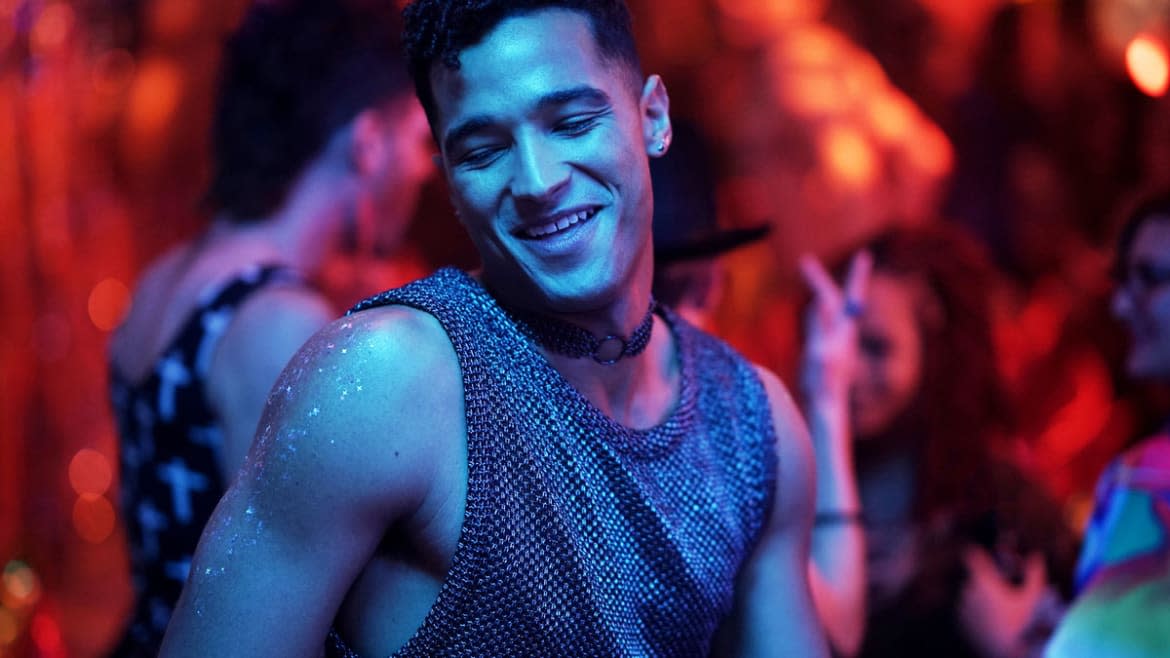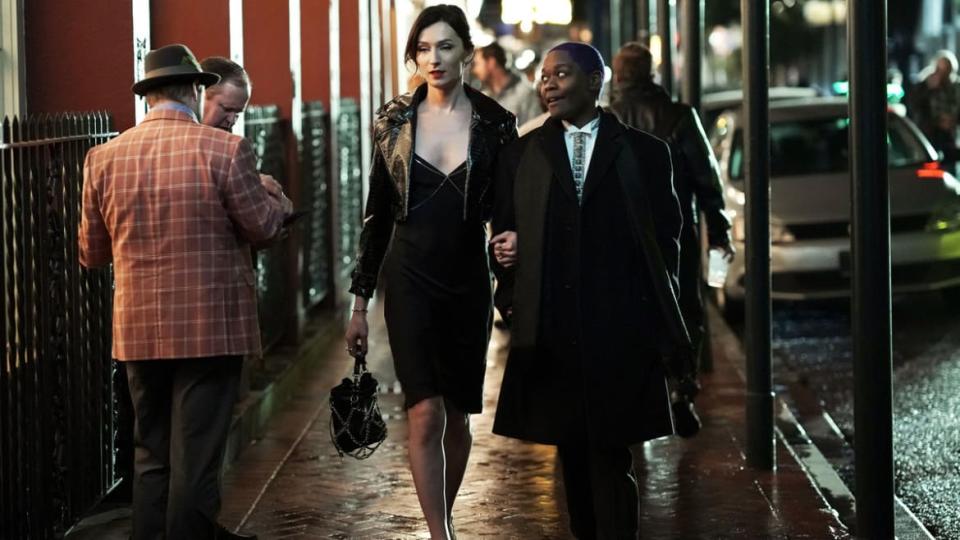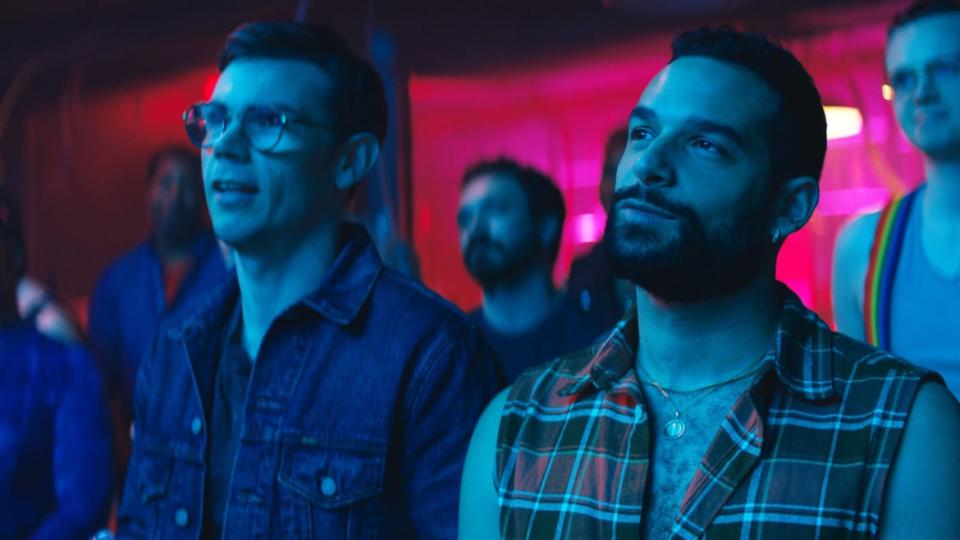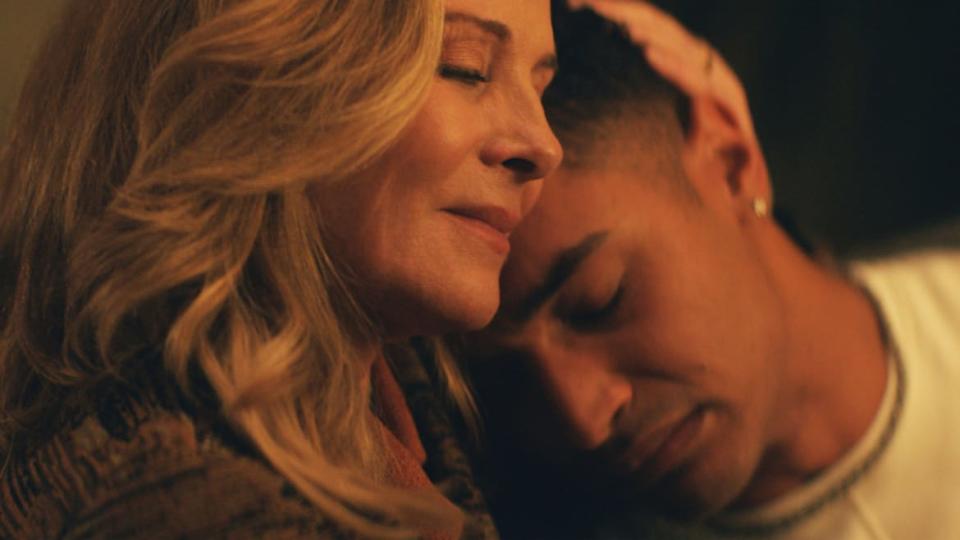‘Queer as Folk’ Has a Lot to Say, and a Lot of Hot Sex While Saying It

- Oops!Something went wrong.Please try again later.
- Oops!Something went wrong.Please try again later.
- Oops!Something went wrong.Please try again later.
There is one symbolic constant in Queer as Folk: the nightclub Babylon, and its pink and blue neon sign. It is there on Manchester’s Canal Street in the first scene of the original British series, made in 1999. It is there in the first American remake set in Pittsburgh, which ran for five years on Showtime from 2000 to 2005, and it is present in the third iteration of the show with all new characters set in New Orleans, the first season of which premieres on Peacock on June 9.
Just as in the first American series, there is an act of murderous hate at Babylon—in this third version’s case a mass shooting in the very first episode, recalling the Pulse massacre—which shakes up the surviving characters’ lives.
The other thing that all three versions have in common: explicit, horny queer sex, and lots of it. Rimming in Queer as Folk is as common as the residents of Genoa City heading to Crimson Lights for a coffee in The Young and the Restless.
‘Queer as Folk’ Is the Latest Show That Needs a Mass-Shooting Warning
What is strikingly different in this third iteration is the diversity of people on screen having all that sex (people of color, trans, non-binary, disabled, and drag-performing characters lead the cast), and the emphatic messaging in the script about the lives and experiences of the communities those characters come from.
This is not, as it was, a show featuring a central cast of hot, able-bodied, cis white lesbians, gay men and bisexuals, yet its script is still lubed with the wit and sass that has been part of Queer as Folk from the very beginning, thanks to its creator Russell T. Davies. (Davies has given his hearty blessing to this new version, created by Stephen Dunn.)
Another big departure: Kim Cattrall may no longer be Samantha Jones, but here she is, playing Brenda, a Martini-mainlining mom with a fluttery Southern accent, and not as conventional as she at first seems.
The eight-episode season opens with the handsome 30-something-looking-way-younger Brodie (Devin Way) returning to town, and into a series of conflicts with his ex-boyfriend Noah (Johnny Sibilly) and trans best friend Ruthie (Jesse James Keitel), who is partnered and about to become a parent to twins with non-binary partner Shar (CG)—thanks to Brodie’s sperm.
Brodie is also reunited with his gay buddy Daddius (Chris Renfro), who is hiding a secret from Brodie, and there is also tension for Brodie with his family, which as well as having Kim Cattrall as mom Brenda includes brother Julian (Special’s Ryan O’Connell, who has cerebral palsy, and who is also a writer and co-executive producer of Queer as Folk).

Jesse James Keitel as Ruthie, left, and CG as Shar in "Queer as Folk."
Meanwhile, also heading to Babylon, is Mingus (Fin Argus), a 17-year-old high schooler with a penchant for skateboarding and dramatic eye makeup, who is about to make his drag debut and who has also lucked out in the TV parent stakes—Juliette Lewis, as his mom Judy, accepts everything about her child; indeed he groans at her constant well-meant intrusions. Just before the firing of bullets erupts, Brodie and Mingus make a connection.
The not-really-significant villains in the show are influencer Jack (Benito Skinner, in a one-dimensional role) who tries to insert himself into the mourning of the tragedy, and fleetingly another white guy who has a BLM lower-back tattoo and who begs Brodie at the beginning of the first episode: “Take me, punish my white ass. My ass takes up so much space. It’s so fucking privileged. Let me pay reparations with my tight hole.”
When Brodie’s request to Venmo some money for a hotel is refused, Brodie says to the guy: “And I thought you were an ally.” If you want to see flesh—taut, muscled, and filmed with sweat—Queer as Folk has a lot of it, and all that sex comes with an emphatic manifesto for many kinds of change.
Just like the first two versions of the show, the politics of Queer as Folk are intrinsic and time-specific. The original British series debuted before the age of consent was equal for gay and heterosexual men, and while lesbians and gay men were banned from military service. Section 28, which forbade the “promotion” of homosexuality—yes, before it was a reviled Russian law, Margaret Thatcher had made it a reality in Britain—was still on the statute books. Queer visibility in pop culture was more patchy than nil.
The first American version took place in the Bush Jr. and post 9-11 years; two of its characters decamped to Canada at the end, and marriage equality was morphing from a whisper to campaign slogan.
The televisual challenge facing this new Queer as Folk is one it helped create. After its revolutionary template of 20-plus years ago, we have had The L Word, Pose, The L Word: Generation Q, and a proliferation of queer characters on the big screen and on network, cable, and streaming TV (most recently in Fire Island, like this series of Queer as Folk featuring lead characters who are not gay white males). This new Queer as Folk is following the second, third and fourth waves of LGBTQ representation on screen that its original series helped generate.
The context of this third version is rooted in the pluralist identity politics of today, contrasted with the regression-pushing demons released into the atmosphere by the Trump administration, and the rabidly anti-LGBTQ Republican-run state administrations of now. This new series appears at a time when queer bars are being literally besieged by bigots; where books and LGBTQ and trans kids and their parents are being targeted by discriminatory law-making; and where calling LGBTQ people “groomers” is an everyday insult.
The mass shooting in Queer as Folk is a reverberating but not cloaking theme for the entire eight episodes. We get to know nothing of the shooter, whose trial unfolds in millisecond updates on mobile phones. All the living characters experience elements of grief and trauma from the incident, and these are sensitively but glancingly sketched.
There is a brief discussion of death penalty versus life imprisonment, but you sense this curious de-centering of such an appalling act of violence is part of the producers’ desire to center queer joy and life in defiance of attacks on the most marginalized. OK, but was a mass shooting a necessary dramatic device to get there? It is hard to de-center an incident so terribly centering. Still, while Babylon is out of commission, Noah’s house becomes a night- and sex club called Ghost Fag, which is possibly the best name for a queer club ever invented.
There are no overt references to the politics of now—the now relentless hate-mongering aimed at LGBTQ people, and trans youth in particular. But the mass shooting in the first episode acts as a parenthesis for the whole season, and within that parenthesis are the characters living their lives. In the current atmosphere of hate and legislative prejudice, these acts of on-screen living so out-loud, are powerful correctives.
The characters relay talk about identities, experience of prejudice, cultural politics, sexual desire and their defiance of whatever norm they feel needs to be challenged with all the lightning speed and over-it tone of the Dawson’s Creek teens who first introduced this slick mode of speaking to television before the first Queer as Folk aired.
This messaging mission is valuable, but curiously toned alongside the necessary mechanics to move the plot forward. Queer as Folk is still essentially a soap opera that weaves its messaging into storylines full of secrets, heartache, betrayal, and romance. The relationship between Brodie and Ruthie is the most profoundly sketched. We follow them back in time to their Catholic schooldays, pre-Ruthie’s transition. In this episode, Ruthie’s previous name, her dead-name, is significantly and cleverly bleeped out. We see her standoff with an ignorant teacher; we see her agony, her coming out, and the roots of her deep relationship with Brodie.
Ruthie is more than a one-note trans character—she used to love partying with Brodie, and Queer as Folk asks if she has to give up her love of hedonism to be a good parent with Shar. Shar themself is a college lecturer, who watches Ruthie’s relationship with Brodie with understanding and frustration. With two grizzling babies, the couple wonder what else they might be missing. Brodie too suddenly starts to think about being more than a non-involved sperm provider.
As diverse as it is, the lead characters of this Queer of Folk do share one quality of their TV antecedents: they’re all good-looking, even if a strand of the series also looks at how (the extremely handsome) Julian perceives himself and is perceived by able-bodied people, particularly alongside his conventionally hot and universally desired brother Brodie.
Sex is central to the show—no change there, and important as LGBTQ sex and sexual desire has been historically absent or minimized in the big and small screen mainstream. Here, the sex is another emphasized sign of diversity (with both who is having it how they are having it shown with explicit pleasure and care). Everyone is so unquestionably into sex one wonders what if there was a character or characters who were not. They would likely be deemed that oh-so-shaming insult “sex-negative,” but they would certainly be the most transgressive and original characters on the show, and a welcome challenge to write for and present on screen.
That said, the presentation of a variety of queer sex is impressive; Ruthie and Shar’s desires are explored as a couple, and then individually. There is coupled pleasure and self-pleasure. One episode puts disabled characters and their sexual desires center stage, and then develops further stories from it. We see the excellent Eric Graise as Marvin and O’Connell’s Julian—refreshingly, they don’t get on, and grouch at one another—both not only have really great sex, but talk about it, and be desired. Julian’s encounter with Nyle DiMarco’s Leo is both hot and a gateway to an unexpected intrigue.

Ryan O'Connell, left, as Julian and Johnny Sibilly as Noah in "Queer as Folk."
Marvin’s relationship with a sex worker, Ali (Sachin Bhatt), becomes an intriguing plot around desire, love, and power, while Julian’s surprising main romantic relationship will ultimately test his relationship with his brother. HIV is present as a theme. Noah’s reliance on drugs during sex is examined in the context of loss (in a less developed and more low-key way, echoing the drug-related storylines of previous Queer as Folk series). His agonizing around this may be tempered on the part of the viewer by observing the gorgeous palace he lives in. There are worse places to ask oneself life’s bigger questions.
Mingus is one of those queer teenagers who has 6,000 fairy lights twinkling in their bedroom, is unnecessarily rude to a frankly amazing parent who many other queers would dearly wish for, and who has a 21” waist. When twink Brodie defines himself as an elder to Mingus, anyone watching over the age of 30 is allowed to emit a scream, silent or extremely out loud.
Mingus’ truer mentor is Armand Fields’ drag queen Bussey, who tries as firmly and tenderly as possible to impart some sense into this already-jaded teen. We have been asked not to expose the big Mingus storyline twist, but it does make the tousle-haired tyke a thousand times more interesting. (Be nicer to your mom, especially when she’s Juliette Lewis!)
All roads ultimately lead back to the central character Brodie, and to the series’ most glaring flaw. While every single character bleats at him that he’s terrible, that chaos follows him everywhere, and that he’s thoughtless, the show never ever sells him as such, or as an overt heel as it did periodically with his antecedents—in the British show’s Aidan Gillen’s Stuart, and Gale Harold’s Brian in American version number one.
Brodie isn’t anything like them, no matter how many times his fellow characters tell him what a jerk he is. He simply doesn’t act like a jerk. He is portrayed as a sexy sweetheart, forever wanting to take care of babies, organizing parties and groups of people, and trying to do the right thing. His most distinctive moment comes when we follow him tripping out on drugs.
If there is a Season 2, and the writers are determined for Brodie to be seen in any way deeper and more mercurial, deeper attention needs to be paid to this central character. Whatever the writers imagine Brodie is, he’s ended up a perfectly languid hottie, and way less complex than intended.

Kim Cattrall, left, as Brenda and Devin Way as Brodie in "Queer as Folk."
Cattrall seems to have been told to play a Tennessee Williams matriarch, and feels a little lost here. While again being asked not to reveal the big twist in her storyline, this viewer can say, sadly, it absolutely does not ring true on screen—indeed leads to one of the most oddly-filmed sex scenes of the whole show. But she does nail a great song in a bar! Maybe this could be the polite alarm bell for Cattrall and Sarah Jessica Parker to sort their stuff out before the next season of And Just Like That, and return Samantha Jones to where she belongs.
The breakout stars of this third version of Queer as Folk thus far are Fields, Graise, Keitel, CG, O’Connell, and Sibilly. The beats of their stories are well-told and performed. Their stories and characters pass the basic soap opera test: you want to know what happens to them, you’re rooting for them, and also occasionally saying, “I can’t believe you did that” at the screen.
There will be those who do not see themselves on screen in the new Queer as Folk, and feel annoyed by that—but then “What about me?” is the eternal complaint made against any LGBTQ TV show or film, because in a world of unequal representation, too few TV shows and films end up having to do all the work. The wish and hope can only be that representation carries on increasing.
As any such kvetching begins, also look at the various forces amassing against LGBTQ people. A queer drama of any kind with politics proudly at its heart—and characters and groups left off the screen up till now, living full, plausibly messy lives—is welcome.
Right at the end of these eight episodes of all-new Queer as Folk there is another Easter egg, or two Easter eggs, which will tickle fans of the original British series. Upon seeing this cute double-whammy, echoing down the years was not just the sweet kick of nostalgia, but a more complex jab as this viewer contemplated how far LGBTQ people had come since 1999, and how precarious that progress now seems to be. It shouldn’t be so anxiety-inducing to imagine the political and social context of another Queer as Folk in 23 years’ time—even if one can take some prophetic comfort that its hot characters will still inevitably be humping away like rabbits.
Get the Daily Beast's biggest scoops and scandals delivered right to your inbox. Sign up now.
Stay informed and gain unlimited access to the Daily Beast's unmatched reporting. Subscribe now.

